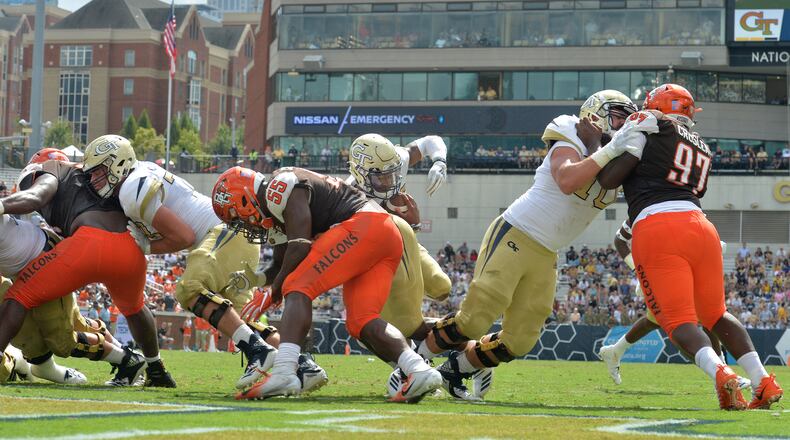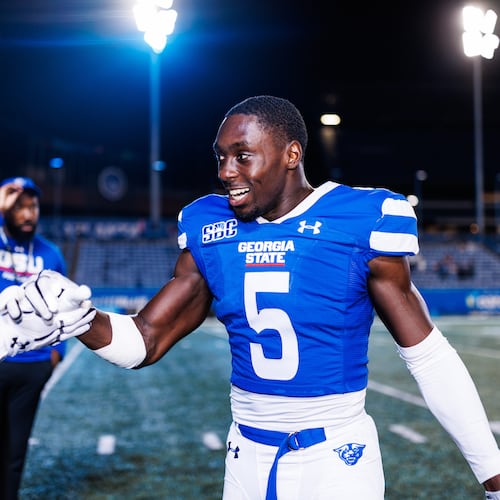Picture a football player coming back from a torn knee ligament. To judge whether he’s ready to get back on the field, the standard evaluation might entail a medical examination and testing, observing a player in practice and in specific drills to test the stability of the knee and asking for the player’s input.
Georgia Tech coach Geoff Collins now has one more technological method in his quiver that can offer useful feedback – wearable GPS devices that can measure how fast a player is running, how often and quickly he is changing direction, accelerating, decelerating and a multitude of other actions.
“If you take one of those guys and you go and you look at the numbers, (and) he’s doing 20 high-speed change of directions to the left but he’s only doing two high-speed change of directions to the right, that leg isn’t strong enough yet to be able to plan and accelerate, or he doesn’t have confidence in it,” said Ryan Horton, Tech’s director of applied sports science, a new position created by Collins. “Either way, that guy’s not ready to be back in live action yet.”
It’s only one usage of the Catapult system that the athletic department has purchased for Collins’ team. Collins used it in his two seasons at Temple, where Horton was an assistant strength and conditioning coach. At Tech, Horton will continue to work with players in the weight room with head strength and conditioning coach Lewis Caralla, but in his new role, his job will be to get as much out of the technology as possible.
“The position here is allowing me to focus more on the sport science side of it,” Horton told the AJC. “It’s freeing me up to dive deeper into stuff, because the rabbit hole goes as far as you want.”
As is the case with other aspects of the team, Tech is playing catchup in utilizing Catapult, which captures more than 1,000 data points per second from each athlete. No fewer than nine other ACC teams use it or a similar system. (Former Tech coach Paul Johnson looked into a GPS system as early as 2015, but the budget could afford four or five units, he said then, and the staff decided to pass. Tech was able to purchase a comprehensive system for the Yellow Jackets this time around.)
But Horton said that, at Temple, the staff was using Catapult “almost as much as, if not more than, anybody in the country,” and he wants to dig even deeper with it at Tech.
“Whether it is researching hamstring (injury) correlations to high-speed velocity running or whether it is different things with change of direction with return-to-play athletes and how to bring guys back from ACL injuries or hamstring injuries or anything like that, and just take it as far as the science will allow us to take it,” Horton said.
The idea is to improve player health, safety and performance. Horton has Collins’ full backing. Horton said that the coach is “extremely” plugged into the Catapult data and open-minded to finding and using new applications for the data.
“It’s something we go over every day, every single day,” Horton said.
With it, Horton can monitor players’ workload in real time and individualize practice plans to ensure players aren’t overloaded in practice, which can limit their game performance or put them at greater risk of injury. Players can check their own numbers and get a sense of their performance in comparison to teammates or their past efforts.
Horton can look to see if a particular player’s numbers are down, perhaps because of a hidden injury or another issue. Data collected from games – players wear tracking devices a little bigger than a credit card, either in a slot on their shoulder pads or in a harness – is “the most important number that we can get the whole year,” Horton said, and dictates training plans.
With that data, Horton said, coaches can more deeply understand what movements each position repeats most frequently and can design strength and conditioning programs accordingly.
“If a linebacker is going to have to be able to change direction ‘X’ amount of times, we want to start making sure that they’re changing direction (in training) and we’re progressing them to be able to do those exact things that they’re going to do based on the position they play,” he said.
Also, it gives the staff a more precise method of preparing players for the season and the preseason. Typically, teams undergo a conditioning test prior to the start of the preseason – completing a certain number of sprints in a certain amount of time.
“But at the end of the day, that’s kind of an arbitrary number,” he said.
The Catapult system has a formula that it uses to boil down a player’s labors into a single number called player load. The staff now knows the precise workload numbers that team members will be hitting on the first week of camp. With that knowledge, the offseason program can be designed to get players to be hitting those numbers when the summer ends.
Horton plans to reach out across the institute to faculty who can help him dig into his data and burrow into his rabbit hole.
“I’ll try to get as far down as I can,” he said.
About the Author
Keep Reading
The Latest
Featured



